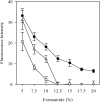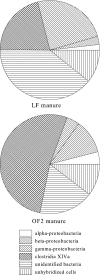Macrolide resistance in microorganisms at antimicrobial-free Swine farms
- PMID: 19633121
- PMCID: PMC2747868
- DOI: 10.1128/AEM.00977-09
Macrolide resistance in microorganisms at antimicrobial-free Swine farms
Abstract
To investigate the relationship between agricultural antimicrobial use and resistance, a variety of methods for quantification of macrolide-lincosamide-streptogramin B (MLS(B)) resistance were applied to organic swine farm manure samples. Fluorescence in situ hybridization was used to indirectly quantify the specific rRNA methylation resulting in MLS(B) resistance. Using this method, an unexpectedly high prevalence of ribosomal methylation and, hence, predicted MLS(B) resistance was observed in manure samples from two swine finisher farms that reported no antimicrobial use (37.6% +/- 6.3% and 40.5% +/- 5.4%, respectively). A culture-based method targeting relatively abundant clostridia showed a lower but still unexpectedly high prevalence of resistance at both farms (27.7% +/- 11.3% and 11.7% +/- 8.6%, respectively), while the prevalence of resistance in cultured fecal streptococci was low at both farms (4.0%). These differences in the prevalence of resistance across microorganisms suggest the need for caution when extrapolating from data obtained with indicator organisms. A third antimicrobial-free swine farm, a breeder-to-finisher operation, had low levels of MLS(B) resistance in manure samples with all methods used (<9%). Tetracycline antimicrobials were detected in manure samples from one of the finisher farms and may provide a partial explanation for the high level of MLS(B) resistance. Taken together, these findings highlight the need for a more fundamental understanding of the relationship between antimicrobial use and the prevalence of antimicrobial resistance.
Figures



References
-
- Akwar, H. T., C. Poppe, J. Wilson, R. Reid-Smith, M. Dyck, J. Waddington, D. Shang, and S. A. McEwen. 2008. Associations of antimicrobial uses with antimicrobial resistance of fecal Escherichia coli from pigs on 47 farrow-to-finish farms in Ontario and British Columbia. Can. J. Vet. Res. 72:202-210. - PMC - PubMed
-
- American Public Health Association, American Water Works Association, and Water Environment Federation. 1998. Standard methods for the examination of water and wastewater, 20th ed. American Public Health Association, American Water Works Association, and Water Environment Federation, Washington, DC.
-
- Angenent, L. T., M. Mau, U. George, J. A. Zahn, and L. Raskin. 2008. Effect of the presence of the antimicrobial tylosin in swine waste on anaerobic treatment. Water Res. 42:2377-2384. - PubMed
Publication types
MeSH terms
Substances
LinkOut - more resources
Full Text Sources
Medical

